A Complete Guide to Camper Van Off-Grid Camping
A Complete Guide to Camper Van Off-Grid Camping
Photo credit: Alex Azabache from Pexels
For those who are used to sticking to established campgrounds or RV parks, off-grid camping might seem appealing but a bit intimidating. Not to worry, we’ve got you covered with some insider knowledge on how to safely camp off-grid, and have fun doing it.
What Exactly is Off-Grid Camping?
Many people aren’t familiar with off-grid camping because they’ve never done it themselves. Off-grid camping is different from “normal” camping in that you camp somewhere on public lands where overnight stays are legal, but you aren’t in a developed campground.
There are many places where off-grid camping is allowed, and we will get into the details of how to find campsites later on in this guide. Dispersed camping has the major upside of solitude and remote beauty, but you will be lacking the amenities and hookups found at most campgrounds. Nothing beats waking up with an entire stretch of land to yourself, but make sure to follow the advice in this guide to safely and responsibly enjoy off-grid camping.
Where Can You Legally Camp Off-Grid?
If you want to camp off-grid, you can’t just pick a point on the map and go camp there. Before you go on a trip, you should research the area you’re visiting to determine whether there are places you can legally and safely camp off-grid.
Unless otherwise stated, it is generally legal to sleep in your vehicle within federally designated lands. These exclude National parks, but include:
- National Forests
- Bureau of Land Management (BLM) lands
- National Grasslands
- Wildlife Management Areas (WMA)
The types of land listed above leave you with hundreds of millions of acres where you can legally camp off-grid for free. While this is awesome news, it’s also not quite that simple. Although camping is generally allowed in these areas, there may be local restrictions.
It’s always a good idea to pick an area you’d like to boondock, and then call the local ranger’s office to learn more about dispersed camping within their jurisdiction. Rangers are usually more than happy to fill you in on exactly where you are allowed to camp and whether any restrictions are in place, such as fire restrictions or bear safety protocol. They may even be able to point you in the direction of some great off-grid campsites, if you’re not already sure exactly where you want to stay.
What Does Your Camper Van Need to Camp Off-Grid?
Camper vans designed with off-grid camping capabilities have some features that make doing so safer and more enjoyable. Some challenges of camping off-grid include a lack of sewage, water, and electric hookups, no immediate access to food or propane, and traveling in remote locations, often on dirt roads and without cell service.
There are endless features and modifications that can make a van more capable of extreme off-grid camping, but with some basic features you can boondock safely and comfortably.
Electricity
Without electric hookups, how will you ensure that your van’s 12-volt batteries stay charged so you can continue to use your lights, fan, charging ports, and more? The most common solution to this issue is to utilize solar panels to keep your batteries charged. Solar panels mounted on the roof of your van supply a reliable source of electricity anywhere the sun shines. Even on cloudy days, solar panels can often harvest enough energy to keep you charged.
In addition to solar panels, it’s a good idea to utilize an oversized lithium battery bank if you plan on doing a lot of off-grid camping. Unlike other battery types, lithium batteries can be safely discharged all the way to zero percent. With a large lithium battery bank, you should have plenty of power to last you a few days without any charging. This is helpful in cloudy or foggy weather, or when you are parked in the shade for days at a time.
Water
When it comes to off-grid camping, arguably the most important feature your van needs to have is a large water tank. A large water tank allows you to stay off-grid for longer, which gives you more freedom when planning a trip. Of course, having extra water is also critical in case of an issue with your van, storm, or another issue that could leave you off-grid for longer than expected.
For safety, we recommend packing an extra 6-gallon water container when camping off-grid. Even if you accidentally drain your Sprinter van’s main water supply, you will have plenty of water to take care of your needs before you are able to refill.
Food Storage & Cooking
Similar to water, you’ll definitely want to bring along some extra food when boondocking in your camper van. While it’s not difficult to pack some extra pantry goods, wouldn’t it be nice to be able to bring along your favorite fresh foods for a week in the backwoods? For this purpose, we feel that a decent-sized 12-volt fridge is a great feature to have when camping off-grid. A fridge allows you to keep perishables fresh while camping, and your solar panels and lithium batteries will keep it running without shore power!
In addition to bringing along extra food, you’ll also want to be able to cook it. Most vans, including ours here at Muse & Co. Outdoors, include a propane cooktop. Every one of our vans comes standard with a 5.5-gallon liquid propane tank, enough to allow you to cook your meals for weeks without running out of gas.
Hygiene
One of the major questions people have about camping off-grid is ‘How do we shower and use the bathroom?’ There are various ways to go about having an off-grid bathroom in your camper van. Here at Muse & Co. Outdoors, we have options for showers and toilets that allow you to camp comfortably off-grid, without taking up too much of the precious space inside of your van.
You have the option to add a Road Shower to your Muse van. The Road Shower is a passive solar-heated water tank that sits atop your van’s roof rack. Since it sits so high, it is self-pressurized. You simply attach a short hose and shower nozzle, and you have a steady flow of hot water. Our shower package includes an optional set of custom curtains that integrate with your Sprinter van’s rear barn doors to provide a private outdoor shower space.
When it comes to using the bathroom off-grid, Muse & Co. Outdoors has you covered. We offer the option to add either a cassette or composting toilet to your van, which stows away in its own integrated storage drawer. These toilet options allow you to do your business in a comfortable and sanitary way while you’re out camping away from it all.
What About Off-Road Driving in a Camper Van?
Many of the dispersed camping areas found in national forests and on BLM land are found miles from highways and paved roads. While Sprinter vans are not a true off-road vehicle, they do have decent clearance and the 4×4 models provide great traction on unpaved surfaces.
By far, the best thing you can do for your van’s off-road capabilities is to buy a 4×4 Sprinter. When paired with a good all-terrain tire, having 4×4 will take care of your traction needs in most easy to moderate off-road situations. Aside from traction, clearance is also a major factor in whether a road will be drivable in your van.
The clearance of a Sprinter van is higher than most vehicles. If you really plan on doing a lot of traveling on more serious dirt roads, you might opt for a suspension lift. This will lift the body of your van higher off the ground, and allow you to swap your tires out for larger ones – giving your van more ground clearance.
Regardless of whether you have 4×4 or extra clearance, you should always travel with an off-road safety kit if you plan on driving on rough roads deep in the backwoods. Your safety kit should include a full-sized spare tire, traction boards (in case you get stuck), a tow strap (in case you get really stuck and need to have someone pull you out), and an extra few gallons of fuel.
How to Find Off-Grid Campsites for Your Camper Van
So, you’re geared up and ready to go off-grid camping! Now, you just have to find a beautiful and quiet spot to camp. We’ve got a few great tips for finding dispersed camping sites.
There are some great smartphone apps that can help you locate off-grid campsites. Campendium is a favorite among van owners. The app allows you to view previously visited and reviewed dispersed campsites on a map. You can check out what others have to say about the site, the road conditions to access it, and even see pictures.
You should always cross-reference the information you find on apps like Campendium with information directly from the local ranger’s office. Anyone can add a campsite to the app, so you should be sure that camping there is legal and safe before heading out.
Another way to find campsites is to simply use a map! After confirming that the area you want to go to has some accessible federally designated land, you can search for roads, pullouts, and potential campsites using a map with a satellite imagery layover. Again, before putting a spot in your GPS and hitting the road, get in touch with the local ranger’s office to confirm that the place you have in mind is legal and safe to camp in. Enjoy your off-grid adventure!
3 Simple But Delicious Recipes for Camper Van Cooking
Photo credit: Muse & Co. Outdoors
Below, we’ve included some notes on considerations when cooking in a camper van, as well as 3 of our favorite #vanlife recipes—one for each meal of the day! Enjoy!
What to Know About Cooking in a Sprinter Van
Cooking in a camper van can be awesome, as long as you know your limitations and how to work around them. Most vans come equipped with either a one or two-burner stovetop with no oven, and limited counter space. While many vans will include a sink with a faucet for doing dishes, it’s usually a good idea to try to conserve water by avoiding a huge mess.
With these considerations in mind, you can still make some great dishes in your camper van kitchen!
Breakfast: Oatmeal, Your Way
One great way to maximize what your Sprinter van kitchen has to offer is to prep some food in advance. If you’re going to break out the pots and pans, you might as well make some extra portions for later meals on the go.
When it comes to breakfast in a van, most people want something that will fuel them throughout their day, without taking too long to prepare. A healthy, quick breakfast gets you out on your daily adventures with energy and time to spare.
One of our favorite #vanlife breakfasts is oatmeal, because you can mix together dry ingredients beforehand, then customize it just how you want when it comes time to eat breakfast.
Ingredients
- 4 cups rolled oats
- 1/4 cup coconut milk powder (optional, but makes your oatmeal more creamy!)
- 1/4 cup brown sugar
- Pinch of salt
- Optional: Dried fruit, nuts, etc.
Instructions
Mix all dry ingredients in a resealable plastic bag and store. When it’s breakfast time, boil some water, add your desired amount of dry ingredients to a bowl, and add hot water slowly until you reach your preferred consistency.
Variations
Once you’ve mixed your hot water in with your oatmeal, you have a “base” bowl that can be built upon in any number of ways. Some favorite additions include:
- Fresh fruit, such as apple slices, berries, etc.
- Cinnamon
- Brown sugar, maple syrup, honey, or sweetener of your choice
- Seeds and nuts, such as: chia seeds, almonds, sesame seeds, walnuts, etc.
- Chopped chocolate, dried coconut, and other dried fruits
Mixing your dry oatmeal ingredients beforehand saves time and dishes, and allowing everyone to make their own custom bowl ensures that the whole family will have a breakfast they will love! Plus, oatmeal is a nutrient-dense food that will give you plenty of power for outdoor adventures. It’s easy to make gluten-free (using gluten-free oats, of course), vegetarian, or vegan.
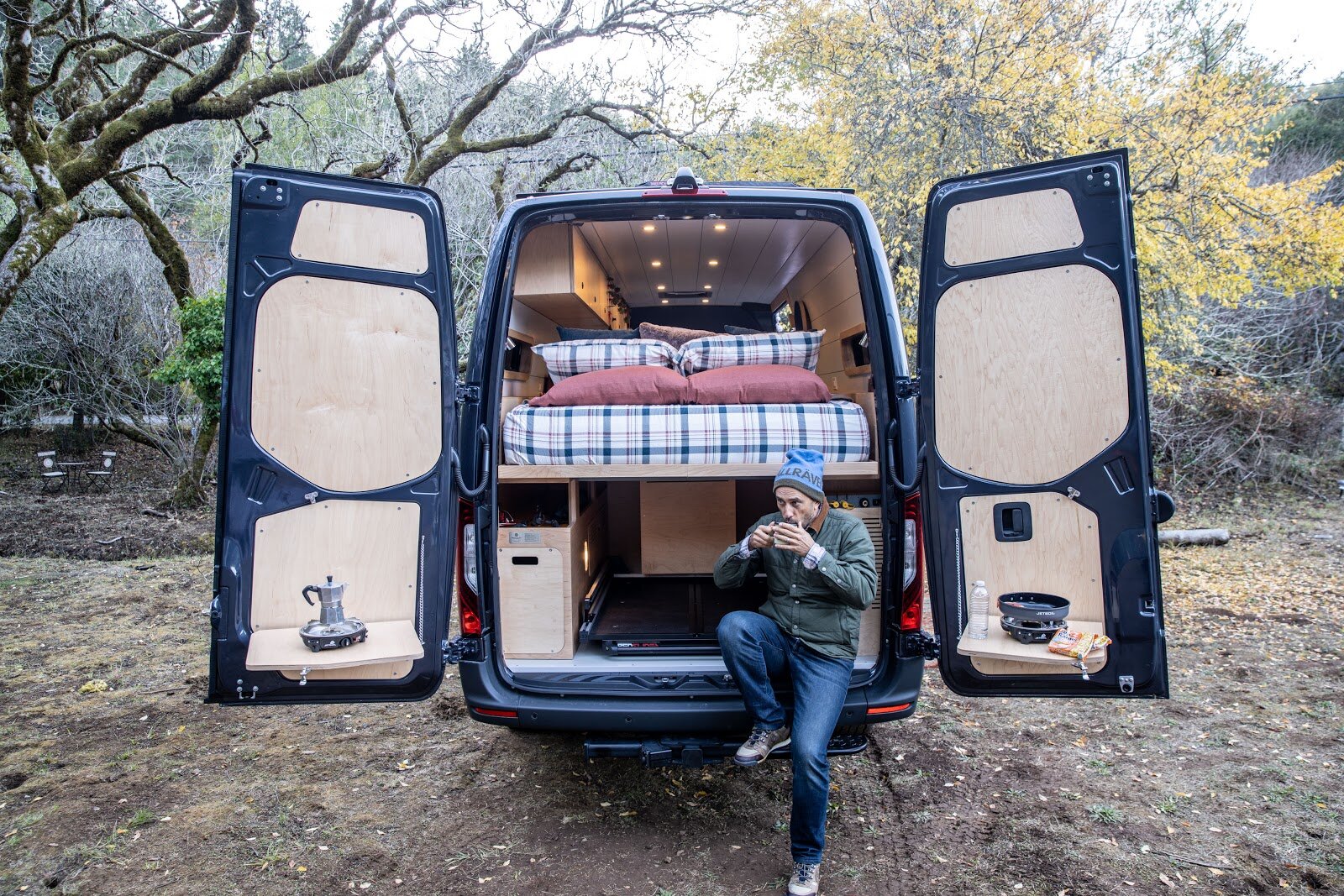
Photo credit: Muse & Co. Outdoors
Lunch: Veggie Wraps
Lunch in a camper van tends to be had on-the-go and during quick pit stops in between adventures. We like to eat something filling but not too heavy, with plenty of nutrition to fuel us for time spent outside. One of our favorite vanlife lunch recipes is these simple veggie wraps, made with hummus and your choice of sliced vegetables. Check out the recipe below:
Ingredients
- Tortillas or wraps of your choice
- Hummus
- Thinly sliced carrots, cucumbers, radish, red bell peppers, onion
- Baby spinach or arugula
- Avocado, thinly sliced
- Fresh, thinly sliced tomatoes
Instructions
Making these wraps is pretty simple! You can tune the ingredient quantities to your needs, depending on how many mouths you have to feed. Add a generous spread of hummus down the centerline of each tortilla, add veggies, and wrap it up like a burrito! If you’re taking it on the go, tin foil and zip-lok bags may come in handy, and you may want to skip the avocado and tomato.
One great thing about these veggie wraps is their versatility. You can use whatever veggies, spread, and wraps you happen to have in the van. If you’d like to add meat such as shredded chicken, you can. Plus, they hold up great if you make them in the morning and take them out adventuring with you. Tip: Cut large quantities of the less perishable vegetables (everything but the avocado and tomato) beforehand, and store in a zip-lok bag to make this recipe even easier to make!
Dinner: Coconut Veggie Curry
Nothing beats a warm and hearty meal after a long day out exploring. We all know that ‘everything tastes better when you’re camping’, but this delicious and easy to make coconut curry doesn’t need much help. This recipe feeds 3-4 people when served over rice, and is a real crowd pleaser with kids and adults alike.
Ingredients
- 1 tbsp olive or coconut oil
- 1 carrot, thinly sliced
- 1 head of broccoli, cut into 1 1/2-inch pieces
- 1 head of cauliflower, cut into 1 1/2 inch pieces
- 1 yellow onion, diced
- 1 1/2 cups of snow peas, heads removed
- 1 can coconut milk
- 1 tbsp curry powder, plus more to taste (or curry paste, if you prefer)
- 1 cube of vegetable bouillon
- Small cube of ginger (3/4 of an inch or so), finely chopped
- 3 cloves of garlic, finely chopped
- Salt and pepper to taste
- Chili flakes (optional)
- Cashews and/or cilantro for garnish (optional)
Instructions
Prepare all the vegetables. Heat oil in a large pot over medium-high heat. Add ginger, garlic, and onion, and cook, stirring occasionally, until onion is translucent. Add carrot, cauliflower, broccoli, and peas and cook for 5-7 minutes, or until softened slightly.
Add the curry powder or paste and stir until all the vegetables are coated. Pour in the coconut milk, and crumble the bouillon cube in. Bring to a simmer, reduce heat, and continue cooking for about 10 minutes, or until vegetables are cooked through.
Serve in bowls over rice. Garnish with cashews, cilantro, chili flakes, and salt and pepper, to taste.
This vegetable curry recipe is another delicious and versatile meal that is easy to make in most camper van kitchens. You can use just about any vegetable that you would put in a stir-fry, and you should feel free to substitute your favorite curry paste for the curry powder. With a short cooking time and just 2 pots used (including the one you’ll use to make rice), this meal is easy to make and a breeze to clean up.
Tips for Staying Organized in a Camper Van
Photo credit: Muse & Co. Outdoors
There are challenges that come with traveling in such a tiny home on wheels, too. If you don’t take care to keep your Sprinter camper van organized, things can get messy and cluttered quickly. While it’s possible to fit amenities like a queen-sized bed and full kitchen into a camper van and still maintain a spacious feel, it is also possible to feel claustrophobic and overwhelmed by the amount of stuff you have in such a small space.
Use the organization tips you find in this article to keep your Sprinter camper van feeling spacious and free from clutter.
Maximize Your Drawer Space
Drawers are a fantastic way to keep items securely stored in a camper van. From kitchen utensils, to food, to socks and underwear, you can store just about anything you might take on the road in a drawer. The main benefit of drawers, as opposed to standard cabinets, is that they allow you to easily access items towards the back.
It’s very important for your camper van’s organization that you keep items neatly arranged in your drawers and maximize the space they offer. For many items, a drawer divider tray will be very helpful. Small items like tools and utensils take up much more space than needed when they are placed loosely in drawers. A drawer divider keeps items organized and separated. It also allows items to be stacked, utilizing more of a drawer’s vertical space and freeing up surface area for other items.
You can also make custom drawer dividers, or talk to your van builder about having them made for you. A custom divider is great for things like plates and bowls in a camper van, because it can be built to maximize drawer space and hold your items securely in place while driving.
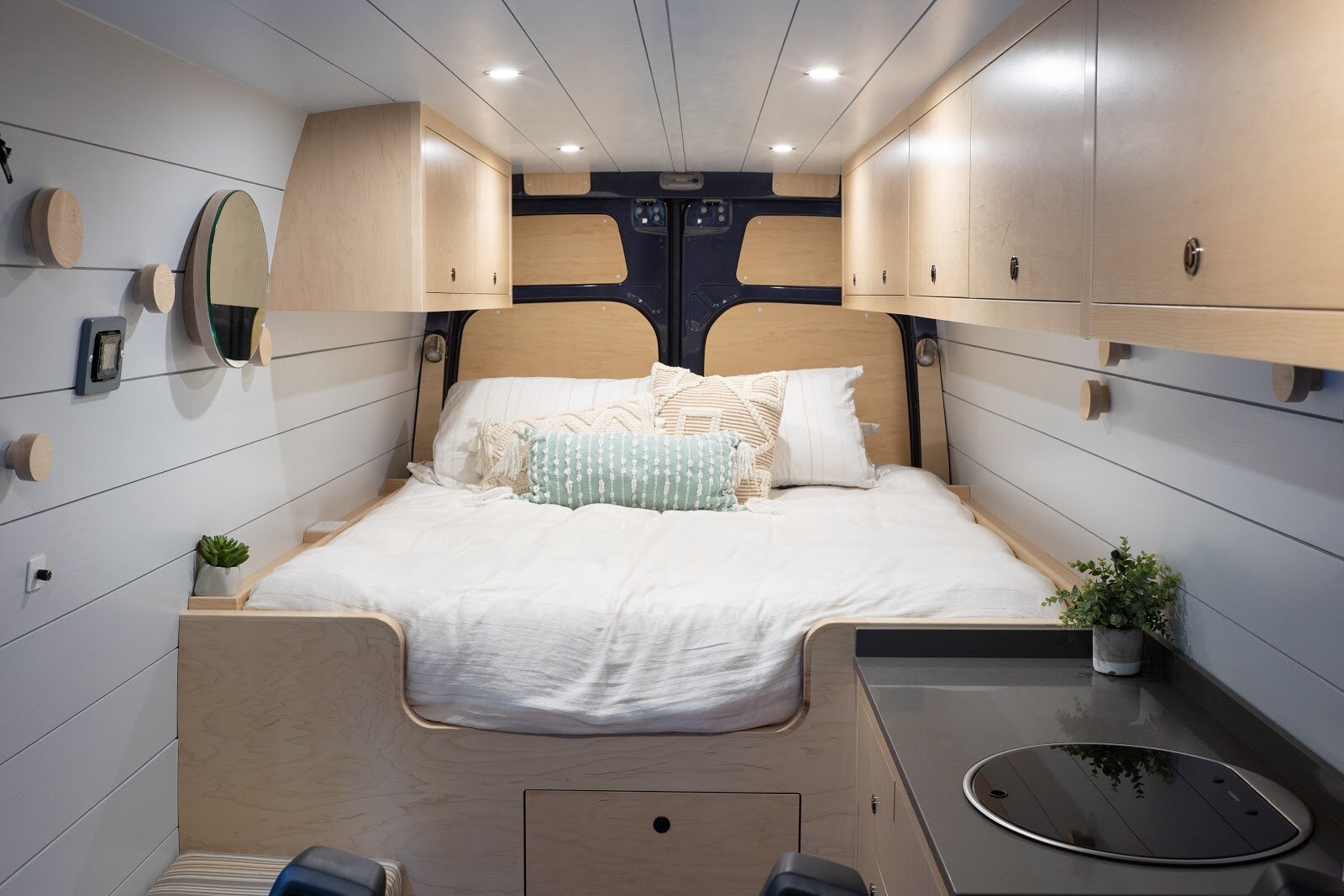
Photo credit: Muse & Co. Outdoors
Wall Hooks for the Win
Some empty wall space in your camper van interior is key to maintaining an open and spacious feel. But your wall space also holds the potential for storing items and enhancing the organization of your van. Utilizing wall hooks is a great way to organize certain items – just be sure you don’t overdo it to avoid a cluttered feel.
Jackets are an item that are ideal for wall hook storage. They are a bulky item that takes up LOTS of cabinet space if you try to store them away. Plus, it’s nice to have quick access to coats so you can grab one before heading outside on chilly evenings. Hanging a jacket or two on strategically placed wall hooks can actually enhance the coziness and home-like feel of your van, while helping to organize it.
Other items that work great when hung on wall hooks include fruit hammocks, headlamps, and toiletry bags.
Have a Designated Laundry Space
Camper vans are small, which means any amount of clutter is immediately noticeable and extra disturbing. Dirty laundry is an inevitable part of being on the road, and how you deal with it can play a big role in how organized your Sprinter van is.
We recommend designating a cabinet or another out-of-the-way nook for storing your dirty laundry. Using a stuffsack can be helpful for compacting the laundry so it doesn’t take up extra space. Try to choose a place for laundry that is accessible from the cabin, but hidden away enough that it’s not encroaching on your space. Rear overhead cabinets or underbed storage areas are good places to keep laundry in a camper van.
Of course, storing your laundry in a designated cabinet has another major benefit: managing odors. If you’re biking, running, hiking, or playing outside in another way, chances are you’re going to be dealing with some smelly laundry. While this may not be a big deal in a large house, any smells in your camper van are going to be easily detectable. Storing your laundry away takes care of this issue.
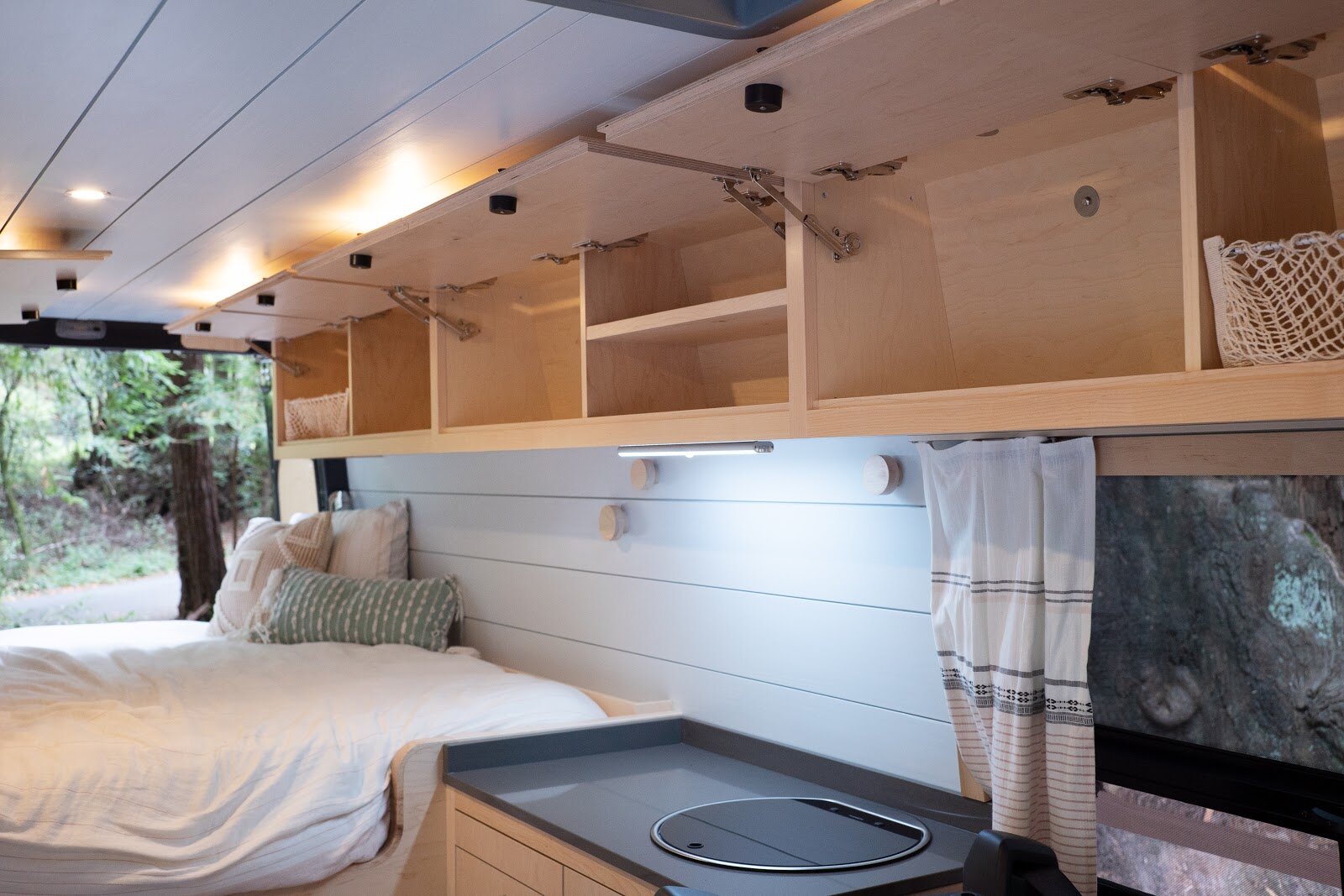
Photo credit: Muse & Co. Outdoors
Practice Minimalism
The #vanlife movement and the minimalist movement have grown side-by-side in recent years, and it’s easy to tell why. Many #vanlifers are moving into their rigs for extended periods of time, and doing so requires a major downsizing of personal items.
Even for those who are using their van for shorter trips, practicing the basic tenets of minimalism can go a long way towards keeping your van tidy and organized. Of course, at the center of minimalism is the idea that you don’t need very much stuff. This concept should certainly be kept in mind while packing your Sprinter camper van for road trips. Bring what you need, but don’t go crazy with packing multiples of things.
Try to get creative with multi-functional items, and keep this practice in mind when packing clothes. Rather than packing a raggedy old pair of hiking pants and your nicest jeans, do you have a pair of pants that can be worn both hiking and out to dinner? These types of packing decisions can make the difference between an organized van, and a cluttered one.
Of course, the very best thing you can do for camper van organization is to buy a camper van that has a well-designed interior with plenty of creative storage solutions. Here at Muse & Co. Outdoors, we’re proud to be crafting some of the most beautiful camper van cabinetry out there, with innovative storage features such as our integrated Bedslide in the rear. Check out our details page for more information!
5 Benefits of Using Solar Power in Your Camper Van
When it comes to camper vans, having electricity is critical for many reasons. Your fridge, lights, heater, and ability to charge laptops and other devices all rely upon a dependable source of electricity. Without electricity, having a camper van just isn’t all that cool!
For the most part, camper van electrical systems share one thing in common: they run off of 12-volt batteries, similar to car batteries but with the ability to complete several hundred cycles of charging and discharging. Still, different vans use different methods to charge these auxiliary batteries, which in turn power your van. That’s where solar panels come in. Solar power has several major benefits when it comes to its use in camper van electrical systems.
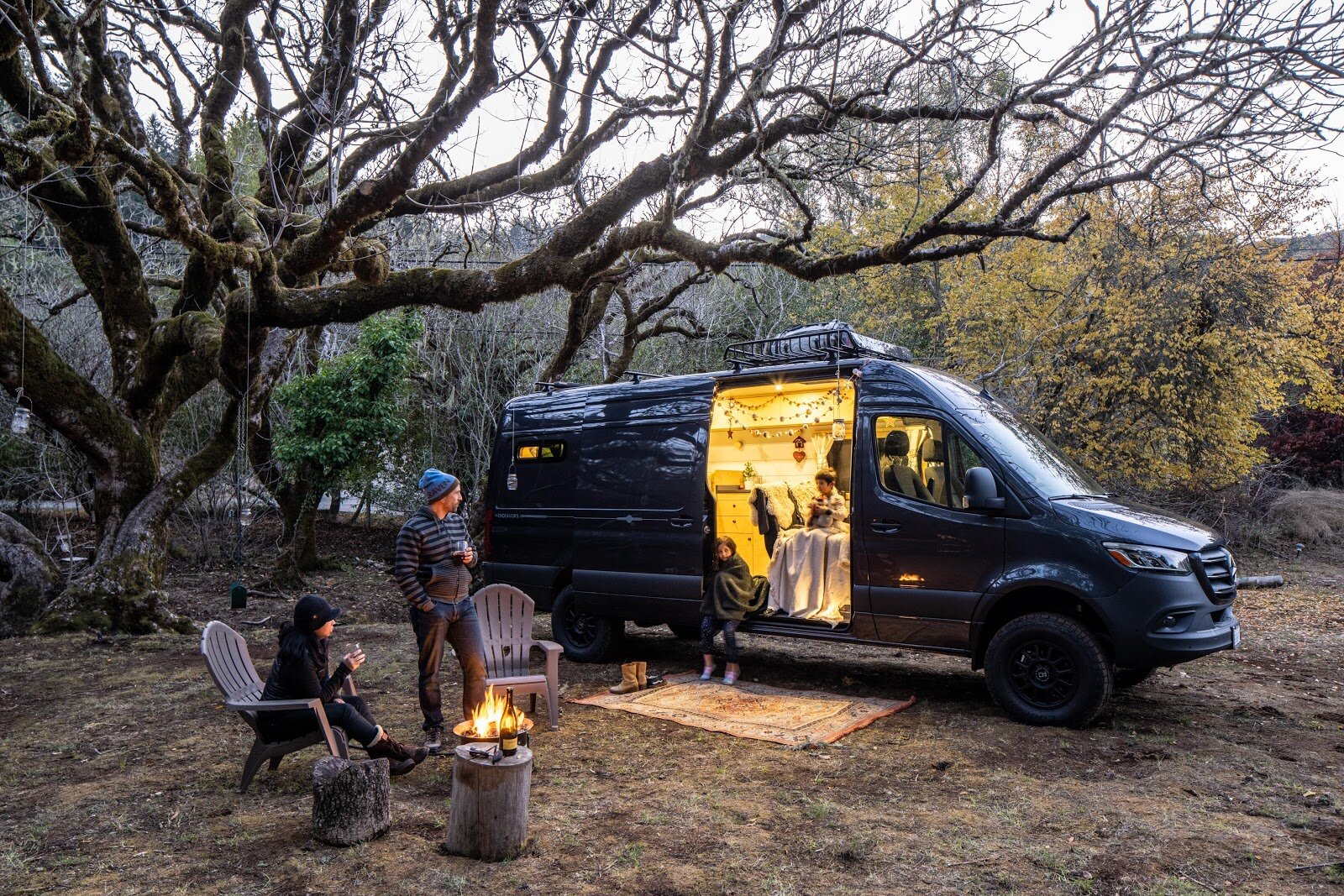
1. Cost-free
Perhaps the greatest benefit of using solar panels on your camper van is their “fit-and-forget” nature. Once installed, solar panels require no maintenance or input to work effectively. Simply wire the panels and secure them to the roof of your van, and you will have a reliable source of power for many years to come, wherever the sun shines.
The same cannot be said for some other sources of charging, including generators. Generators not only require the purchase of gasoline to run, but they also will inevitably need some maintenance down the line. The only form of upkeep you need to undergo with your solar panels is cleaning them intermittently to ensure maximum output. This is achieved easily with the addition of a ladder to your camper van.
2. Clean Energy
One major benefit of utilizing solar power in your camper van is the sustainable nature of this power source. Unlike gasoline-powered generators and grid electricity which comes largely from coal-fired power plants, solar power is a completely clean and renewable energy.
If you are using your Sprinter van conversion like most people do, to access the beautiful outdoor spaces you love, then you probably understand the importance of relying on clean energy sources to protect our planet. The amount of electricity used by a camper van is not huge in the grand scheme of things, but every little bit counts. Plus, adding solar panels to your camper van puts money in the green energy industry, which, in turn, helps it to grow.

3. Off-Grid Capabilities
If you want to take your camper van off-grid, solar power is a must. Nothing beats the freedom of being able to camp wherever you want, regardless of whether hookups are available. Solar panels allow you to rely entirely on the sun’s rays to keep your food cold, your devices charged, and your lights on!
If you are concerned about running out of power during cloudy weather, this is rarely an issue. Solar panels are still capable of harvesting some of the sun’s energy, even in cloudy or partially shaded conditions. And, if you have enough battery storage, you should be able to last for a number of days without charging the batteries at all. Just a few hours of full sun is enough to fully charge most camper van battery banks.
4. Sleek and Space-Saving
Another great thing about solar panels is their mounting location on your van. In order to maximize sunlight exposure, you’ll want to mount your panels on the roof of your van. This frees up precious space inside of your rig that might otherwise be used by a generator.
Most solar panels are an inch thick or less. Their low profile means that you probably won’t even be able to see them from the ground. And, given the large size of Sprinter van rooftops, you’ll still have plenty of room for gear and accessories up there.
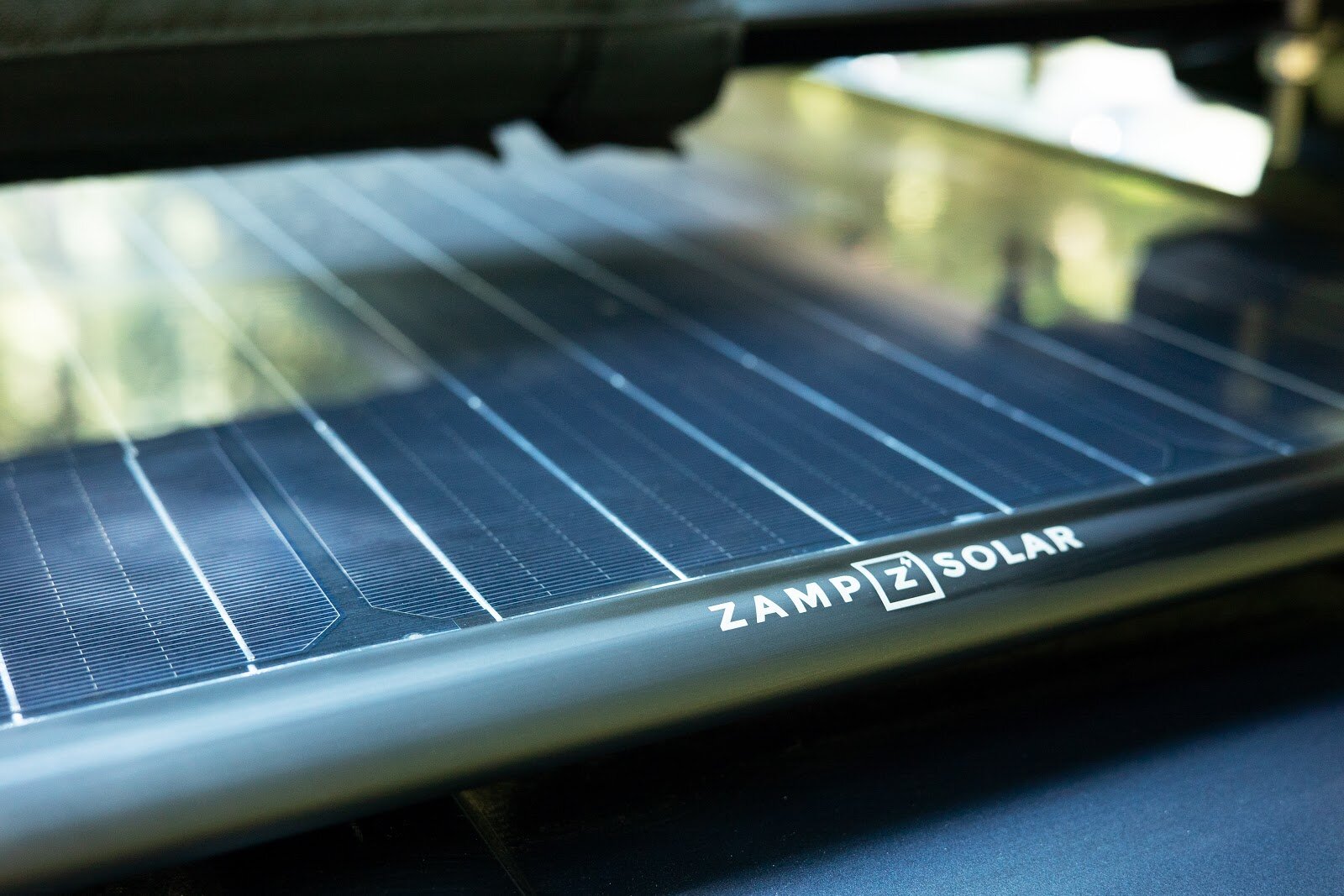
5. Durability
You might be concerned about how long a piece of glass will last on the roof of your van. Rest assured, however, that solar panels are up to the task. The life expectancy of solar panels is 25 to 30 years. After this amount of time, they don’t stop producing electricity – but they lose enough efficiency to bring them below industry standards. It’s likely that your solar panels will outlast the Sprinter van itself.
Solar panels are not just durable, they are rugged as well. Most panels are built to withstand decades of harsh sun, wind, rain, snow, and even hail. In fact, high-quality solar panels are specifically tested to ensure that they can withstand moderate to large sized hail. As long as they are installed securely by your professional camper van outfitter, the panels will have no trouble withstanding the high wind speeds of the highway.
Every Muse & Co. Outdoors camper van comes equipped with 400 watts of Zamp Obsidian Solar Panels. Zamp Obsidian panels are American made, premium quality solar panels. They are ultra low-profile, extremely lightweight, and very durable. The solar panels easily charge the 400Ah deep cycle lithium batteries located on board.
How to Work Digital Nomad Jobs From Your Camper Van
More people are working from home now than ever before. Many companies that were forced to switch to a remote work format due to the coronavirus pandemic have seen no drop in efficiency from workers, and have since told employees that they can continue to be remote workers indefinitely. It seems likely that remote work is here to stay.
Factors like the low cost of living, coupled with the popularity of remote work, are encouraging many people to work remote jobs while living in camper vans.
The #vanlife has exploded in popularity recently. So many people are working remotely and traveling that a new term has been coined to describe them: digital nomads.You don’t need to travel to an exotic country in Asia like Bali or Thailand to be a digital nomad; many people are taking their work on the road in their home country by living out of Sprinter vans!
Of course, working a location-independent job from the road comes with a new set of challenges when compared with working from home. With the help of a few tips and gadgets, it is possible to work remotely while traveling in your camper van. Use this guide to learn everything you need to know about working from the road in your Sprinter van!
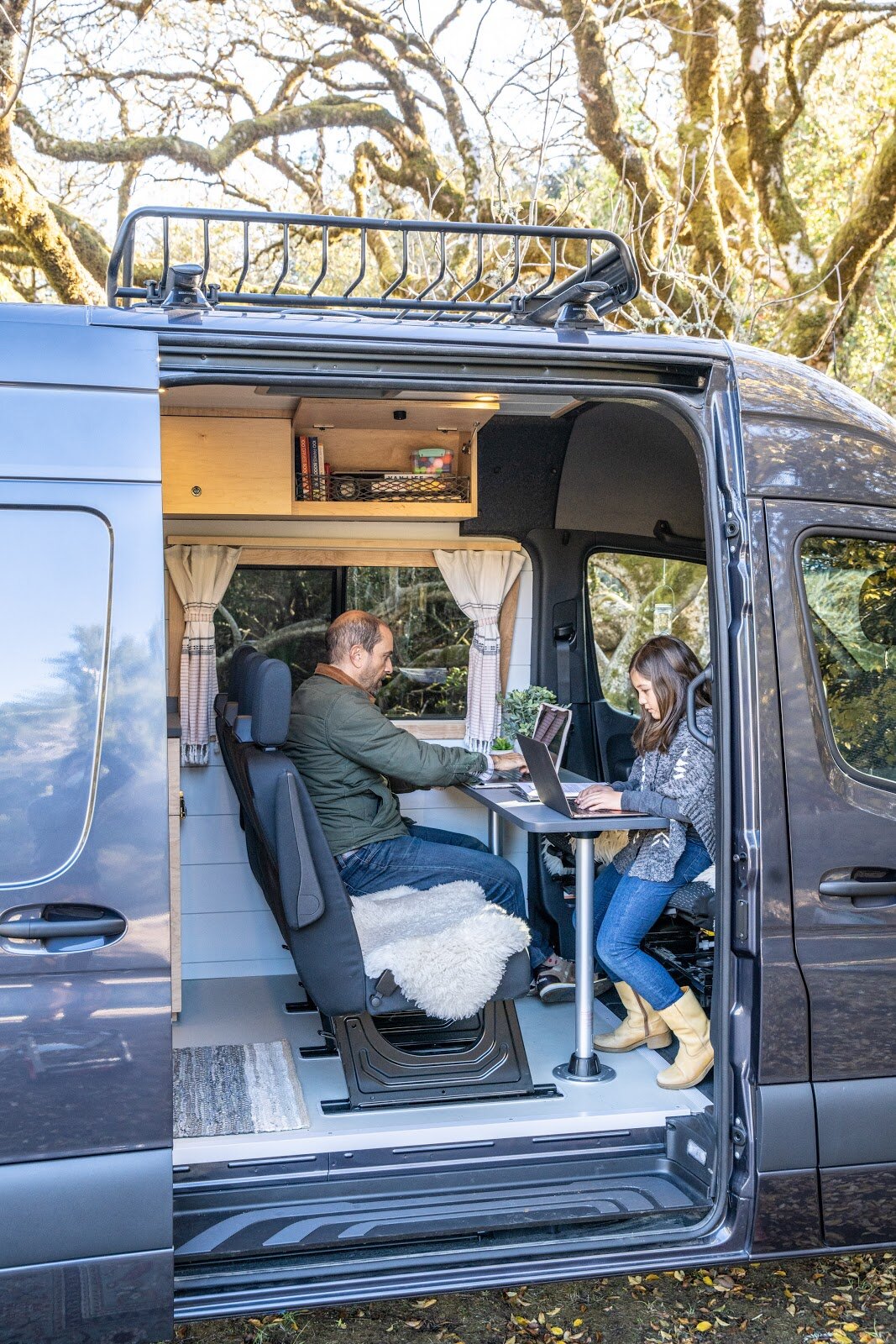
Best Jobs for the Digital Nomad Lifestyle
Many people are interested in being a digital nomad, but they don’t know where to start. The digital nomad community is a diverse group of workers from a spectrum of industries.
Many digital nomads work freelance gigs with flexible part-time schedules, such as:
- social media specialists
- copywriting experts
- graphic designers
- travel blog writers and other bloggers
- SEO specialists
- virtual assistants
- affiliate marketing specialists
- web development specialists
Others work full-time jobs from the road in their sprinter vans. And some people set up ways to earn a passive income, such as renting out a property on AirBnB. Some students even take online courses while living out of their vans!
For beginners who don’t have a remote job yet but want to live the digital nomad lifestyle, online job boards like Upwork, Fiverr, Linkedin, and Indeed are good places to start your remote job search and start to make money online.
How to Access the Internet on the Road from Your Camper Van
Perhaps the greatest challenge when it comes to working from the road is finding the internet access you need. If you’re going to work for a startup or run your own business from the road, you’re going to need a good internet connection.
Campgrounds with WiFi
One of the simplest and most reliable ways to access the internet while traveling is to choose campgrounds and RV parks that offer WiFi. While there are few traditional campgrounds that have WiFi, many RV parks offer a strong WiFi connection, right at your campsite. With a little planning, you can map out a route that puts you in campsites with internet access when you need it.
Public WiFi/Co-Working Spaces
Even during the pandemic, when accessing the internet from a coffee shop may not be an option, you can find a reliable internet connection in many locations. Many public parks and downtown areas offer free access to WiFi, with more public WiFi access being added every day.
Another great option for digital nomads, especially those who work full-time from the road, is to find a co-working space in the area they are staying. Co-working spaces can provide a great home base during busy work weeks and usually have the amenities you need to work comfortably.
Another benefit of co-working spaces is that you are likely to meet like-minded people who run their own online businesses and work from the road.
Cell Phone Tethering
Cell phone tethering is one of the most common ways that digital nomads access the internet while on the road. By using your cell phone as a personal hotspot, you can tether it to your computer and use your phone’s cell signal to access the internet. If you use this method often, you will want to have an unlimited data plan to accommodate the increase in data usage.
So, what do you do if you are relying on cell phone tethering to work remotely, and your signal isn’t as strong as you need it to be? In these scenarios, there’s a gadget that can really save your workday: a cell phone signal booster. Cell phone signal boosters are like a megaphone for your mobile device. They take your cell phone’s signal and amplify it by several times to give you a fast connection where there is normally poor service.
These devices will rarely give you a fast enough signal if you have no service to start with, but in areas with a lower than optimal signal, they work fantastically. The best cell phone signal booster for camper vans is made by weBoost and costs around $500.
Other Gadgets
Cell phone signal boosters are the most popular option for accessing the internet on the road, but they aren’t the only gadgets that can help you get WiFi when you need it. Other options include satellite internet and WiFi range extenders.
Satellite internet receivers can be installed on your van. Theoretically, they give you reliable access to the internet, no matter where you are. Unfortunately, satellite internet has a reputation for being unreliable. WiFi range extenders are a good addition for some types of travelers. They take an existing WiFi signal and amplify it, making it stronger than it otherwise would be in your camper van. These work well in certain situations, such as when you are parked outside of a coffee shop or a friend’s house and you need to amplify the WiFi signal.
Camper Van Must-Haves for Digital Nomad Life
Reliable internet access is essential for being able to work on the road. Additionally, you’ll want to be sure that your camper van is outfitted with some basic features to make working remotely possible. Below, we’ve outlined some of the must-have camper van features for working remotely:
A Workspace
It may seem obvious, but if you are going to work from your camper van, make sure it has a comfortable and functional workspace. Like most features in your camper van, your work area can have multiple uses. Many vanlifers opt to work at their table, which doubles as both a desk and a dining area.
Not all van designs include a dining area, so be sure that you choose a Sprinter van with a comfortable place to work. Swiveling captain’s chairs are a great addition that can open up your living space and allow you to work comfortably for long periods of time.
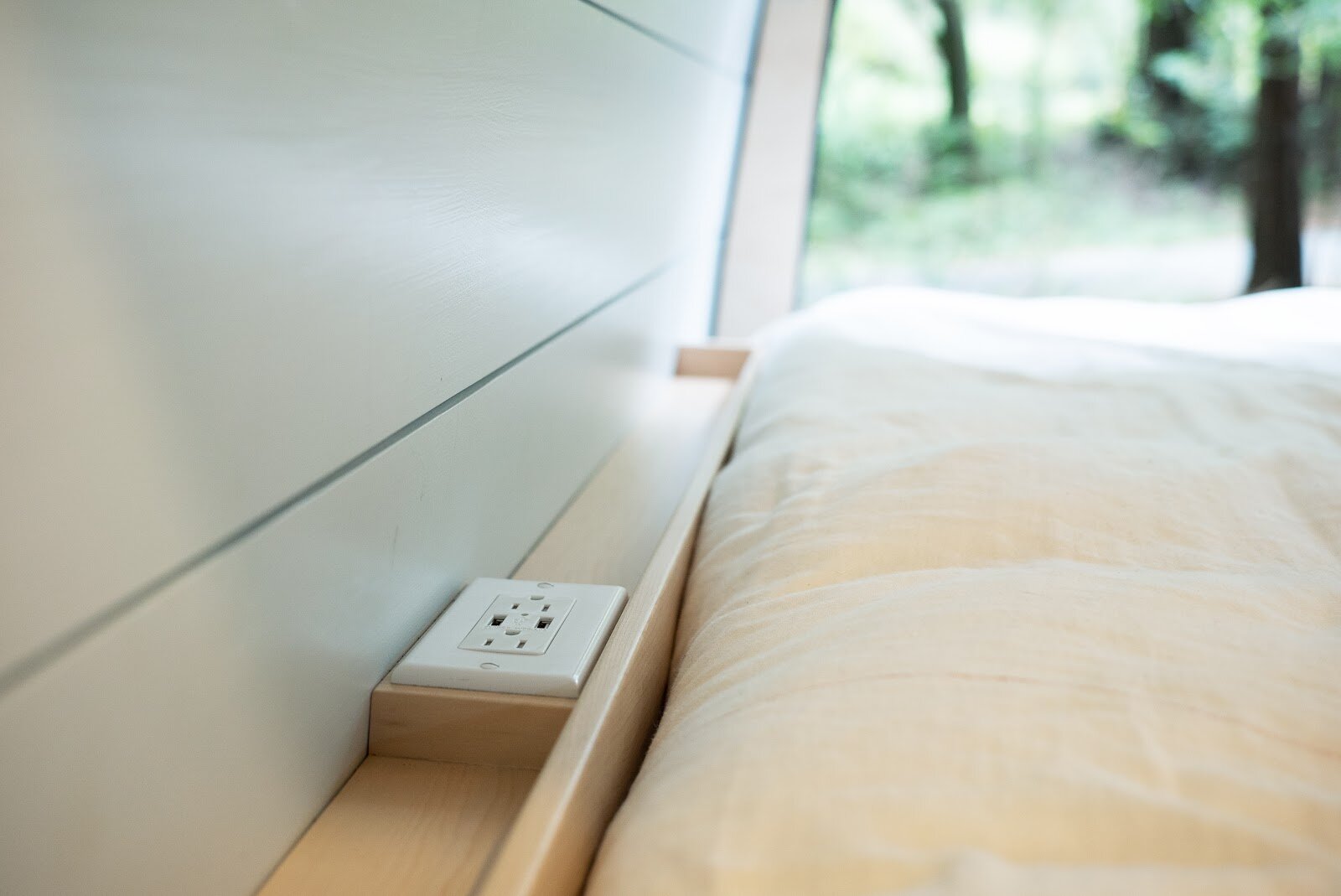
Charging Capabilities
In order to be able to work from the road, you’ve got to be able to charge your devices. Most camper vans come equipped with a 12V DC electrical system, but your laptop is built to plug into a standard household 120V AC outlet. In order to charge your laptop in your camper van, you’ll need a pure sine wave inverter and convenient outlets in your living area. The inverter converts the 12V DC power to 120V AC, so you can use normal household outlets to charge your laptop and other devices.
Of course, your van will also need a way to charge its batteries so that you can work reliably while traveling. It’s good to be able to plug in when you have shore power accessible, such as outside your home or at an RV park. But your van should also have off-grid charging capabilities for times when shore power is not available. For this, harnessing the energy of the sun by placing solar panels on the roof of your van is a great option.
If you find yourself working from home and dreaming about all the places you could be, turn those dreams into reality! A Sprinter camper van with the right features and equipment can allow you to be in the places you love while continuing to work remotely. Whether you are looking to travel for a weekend or weeks on end, an interior build from Muse & Co. Outdoors will allow you to play, work, and travel to the places you love in style.
How to Stay Healthy During a Camper Van Road Trip
Sprinter camper vans make for an awesome way to travel. The comfort and features of a camper van make it possible to take extended road trips that last weeks or even months. Many people have even begun to move into their vans full-time, working remotely as they travel the world.
One of the challenges of these extended camper van road trips is the loss of your normal at-home routine. While traveling allows for freedom and spontaneity, it can also make it difficult to keep up with daily routines and practices that keep you feeling healthy. Your diet, exercise routine, and more are likely to undergo major shifts while you are on the road.
So, how can you stay healthy while you’re on the road in your Sprinter camper van? We’ve got some tips that are sure to keep you feeling great while traveling. Keep reading to learn more!

Move, Move, Move
One of the major challenges when it comes to staying healthy on the road is the inevitability of sitting for long periods of time. Long days spent driving can be taxing on the body, as extended periods of sitting lead to tightness and sore muscles. Van life can lead to a lack of movement in other ways, too – if you encounter bad weather or you are working from the road, you might find yourself spending long days inside of your van.
So, how can you combat extended periods of sitting in your van? The key is to find ways to move your body throughout the day, even during those marathon travel days. Incorporating even small amounts of movement into an otherwise long day of sitting in your Sprinter van can make a huge difference in your mood, energy levels, and how your body feels.
During travel days, try getting some movement in every time you stop for gas, food, or bathroom breaks. Stretching is a great way to realign your body after long periods of sitting. Getting your heart rate up and blood moving is also a good idea – jumping jacks, a short jog around the rest area, even some push-ups in the van are all great ways to keep your body limber while traveling.
Eat Well
It can be very challenging to make sure you are eating well and getting proper nutrients while traveling, but doing so is extremely important. While on the road, you may not have access to the same foods that you do at home. Plus, although many custom Sprinter vans come equipped with a nice kitchen, you are still likely to be somewhat limited with what you can cook in your van.
Eating well on long road trips is still possible. With proper planning and a little flexibility, you can continue to get proper nutrition and feel great while traveling in your camper van. Employ the following tips to keep yourself eating well while on the road:
Bring your favorite staples
You might not be able to find your favorite foods while traveling, but with a little planning, you can bring extra with you on your trip. Before leaving on a road trip, stock up on your favorite healthy pantry foods. Your body will thank you later.
Make extra
Cooking in a camper van is easy enough, but you’re not likely to be as motivated to make time-consuming meals on travel days when you’re on the go. To avoid eating fast food and snacks from gas stations, prep some extra food when you do make a big meal in the van. Leftover veggie stir-fry or pasta with pesto is going to make for a much healthier lunch than a greasy burger with fries.
Snack smart
One way to ensure you eat healthily while traveling in your Sprinter van is to only buy healthy foods at the store! We get it, snacking is an essential part of long road trips — but you can easily replace those potato chips and gummy worms with healthier options that will leave you feeling much better. Some favorite snacks that are easy to find in most grocery stores include carrots with hummus, fresh fruits like apples and oranges, and organic low-fat bagged popcorn.
Start the day off right
We’ve all heard it before: “Breakfast is the most important meal of the day”. Whether or not you agree with this age-old saying, it’s certainly true that starting your day with a healthy breakfast sets the tone for the rest of the day and gets your body the nutrients it needs, right off the bat. You don’t need to cook an extravagant meal to have a healthy breakfast. A simple bowl of oatmeal or granola with yogurt and fruit is fast, easy, and nutrient-dense.

Don’t Stress!
Getting proper exercise and eating well are obvious ways to keep your body feeling great while you’re traveling. But stress also plays a major role in our energy levels, mood, digestion, and even levels of muscle soreness.
Travel-induced stress is a common issue. While you might be having a blast on your road trip, the stress of being on the move and trying to make decisions can add up. Stress can be mitigated by finding a balance between thorough planning and a ‘go with the flow’ attitude.
Planning your trip well enough to have some activities lined up and to know where you will be sleeping each night can go a long way towards mitigating stress on the road. At the same time, life happens and you never know what could occur while you are on a road trip in your Sprinter van. While planning helps, you should also be prepared to make some decisions on-the-fly and allow for some spontaneity in your journey.
It doesn’t matter how beautiful the landscape is; if you aren’t feeling well, it will be hard to enjoy your trip. Use these tips to stay healthy during your camper van road trip, so you can feel great and have the time of your life!
~ Wishing you a healthy trip. Your friends at Muse & Co. Outdoors
The Ultimate Guide to Winter Travel in a Camper Van
One of the major reasons why camper vans are so much better than tent camping is that they provide a more robust barrier between you and the elements outside. With proper outfitting and the right preparation, your van can feel like a cozy cabin on wheels, even in full winter conditions!
Taking trips in your Sprinter camper van is totally possible during winter. In order to stay warm, dry, and safe, a little extra planning is needed. Use this guide to learn about the best gadgets and tips for wintertime camper van travel.
Staying Warm
The main concern when camping in the winter is, well, that it’s cold outside! Even if you’re the type of person who enjoys outdoor winter activities such as skiing or snowshoeing, you’re going to want a warm and dry place to rest and relax at the end of your day. There are some key elements needed to keep your camper van interior warm and cozy during the winter.
Insulation
When it comes to winter travel with a camper van, nothing is more important than insulation. Insulation in a van has two main purposes: temperature regulation and moisture control. The best insulation for the job is Havelock Wool. Havelock is a natural sheep’s wool insulation that is sustainably sourced and entirely natural. It boasts an excellent R-value per square inch, meaning that it is more efficient at keeping your van warm in the winter than other insulations.
Havelock Wool is also a natural regulator of moisture. This is critical in a camper van because prior to being built out, a Sprinter van is essentially a metal box on wheels. When conditions are right, such as when it is cold outside and warm and humid inside, condensation can build up on the interior walls of your van. This can create issues with mold and wood rot that can ruin your camper van! Fortunately, Havelock Wool naturally absorbs moisture when it appears, and gradually releases it as the air dries out.
Every Muse & Co. Outdoors van comes fully insulated using only R7 Havelock Wool insulation. That’s why our vans stay so warm and cozy on those winter trips!
Dry Heat
Effective insulation will help to keep the heat inside of your van, but there’s got to be a heat source to begin with. Every Muse & Co. Outdoors van comes equipped with an Espar D2 heater. The Espar D2 is a state-of-the-art heater designed specifically for use in camper vans. It taps straight into your Sprinter van’s massive diesel fuel tank and is powered by your 12-volt off-grid electrical system, so you never have to worry about running out of heat.
The most important feature of the Espar D2 heater is that it provides “dry” heat. This means that the D2 does not contribute to condensation build-up inside of your van, because it is externally vented. This also means that all the fumes from the heater are expelled outside of the van, so you can safely run it with all your windows and vents closed without worrying about CO poisoning. The D2 provides thermostat-controlled heat, so you can set it to whatever temperature you’d like and enjoy your personal winter retreat.
Staying Safe
Another major element of winter travel is safety. If you plan on traveling in the mountains or anywhere it snows during the winter, it is critical to be prepared and bring the right safety equipment.

Traction is Everything
The two biggest hazards when it comes to winter travel in a van are losing traction while driving on snow-or-ice-covered roads, and getting stuck on a backroad or at a campsite due to deep snow. These hazards should be taken seriously, but with the right equipment, you can avoid these dangerous scenarios and safely enjoy winter travel in your Sprinter van.
The best way to ensure you don’t lose traction is to get a 4 wheel-drive Sprinter van. When it comes to driving in winter conditions, there is no comparison between 4wd and 2wd vans. Simply getting a 4wd van will help you to avoid most of the hazards of winter travel.
Even with 4wd equipped, your vehicle’s traction is completely reliant on the contact it makes with the surface you are driving on. That is why snow tires are an absolute essential if you plan on taking winter trips in your van. Snow tires are specifically designed to provide traction when roads are covered in snow and/or ice.
Even with 4wd and snow tires, roads can sometimes be so icy that more traction is needed. In these cases, a good set of tire chains are a must-have. If your van is 2wd and/or you don’t have snow tires, chains are an absolutely essential part of your winter travel kit. In many states, including California, you are required by law to carry chains when driving a 2wd vehicle over mountain passes during the winter.
Be Prepared
It is highly recommended that you bring a winter recovery kit along during snowy trips in your campervan. A winter recovery kit is a set of tools you can use during worst-case scenarios, such as if your van were to get stuck in the snow on a backroad. Your kit should, at a minimum, include traction recovery boards, a small snow shovel, and a tow strap. Of course, you should always aim to assess conditions and avoid getting stuck—but in sticky situations, these tools can help you turn a trip-altering fiasco into a 30-minute setback.
Finally, if you are traveling during the winter in your Sprinter van, make sure to bring some extra non-perishable food, ensure that your fuel and propane tanks are full, and carry extra water in an insulated area of your van. These preparations are especially important if you plan on traveling far from towns and main roads during your trip. If you were to get snowed in and have to hunker down in one spot for a period of time, having ample fuel, food, and water would be critical.
Be sure to check out Muse & Co. Outdoors’ options and packages to learn how we can help you outfit your Sprinter van for comfortable and safe winter travel.
7 Awesome Van Life Accessories, Gadgets, and Gear
There’s no question that #vanlife is awesome. Thousands of people across the U.S. are hitting the road in converted Sprinter camper vans. Whether you are a weekend warrior or a full-time traveler, camper vans can offer a compact but functional living space to make your dream adventures a reality.
Even the best builds can be greatly improved upon with the addition of some well-chosen gear. From ladders to bug screens, these simple additions to your camper van will help to make your adventures seamless and fun.
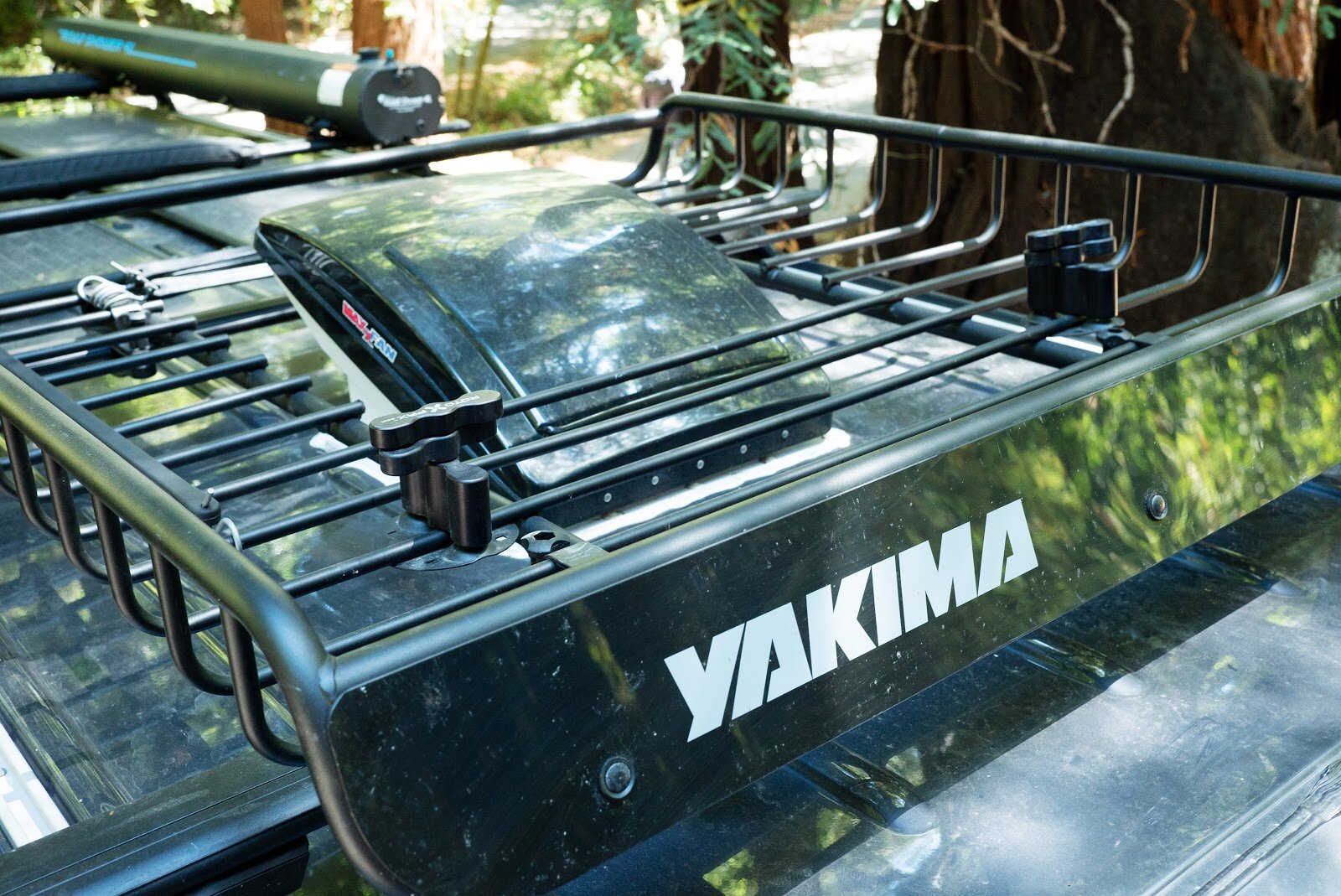
Roof Rack
Not all vans have roof racks, but for many vanlifers, this is one accessory they just can’t live without. These days, many companies are custom-building roof racks to seamlessly fit specific Sprinter van models. Roof racks are handy for attaching solar panels to, and carrying extra gear such as surfboards and kayaks.
Some people who need more storage for smaller items add a cargo box to their van’s roof rack. Additionally, certain amenities such as Road Showers and awnings require a roof rack for mounting. As an added bonus, racks just happen to make your rig look way more badass.
Awning
You’ve probably seen vans with awnings before. Way back in the 1970s, people began adding awnings to the side of their VW Bus campervans. There’s a reason why people still add awnings to Sprinter vans today – it’s because they’re awesome!
The most popular place to mount an awning on your van is over the sliding door. When deployed, an awning creates a covered outdoor space with protection from rain and sun. First and foremost, a camper van is a tool to get you outside to the places you love, and an awning allows you to truly be outdoors while staying comfortable. Most awnings require a roof rack for mounting, so here’s your excuse to get that awesome rack you’ve had your eyes on.
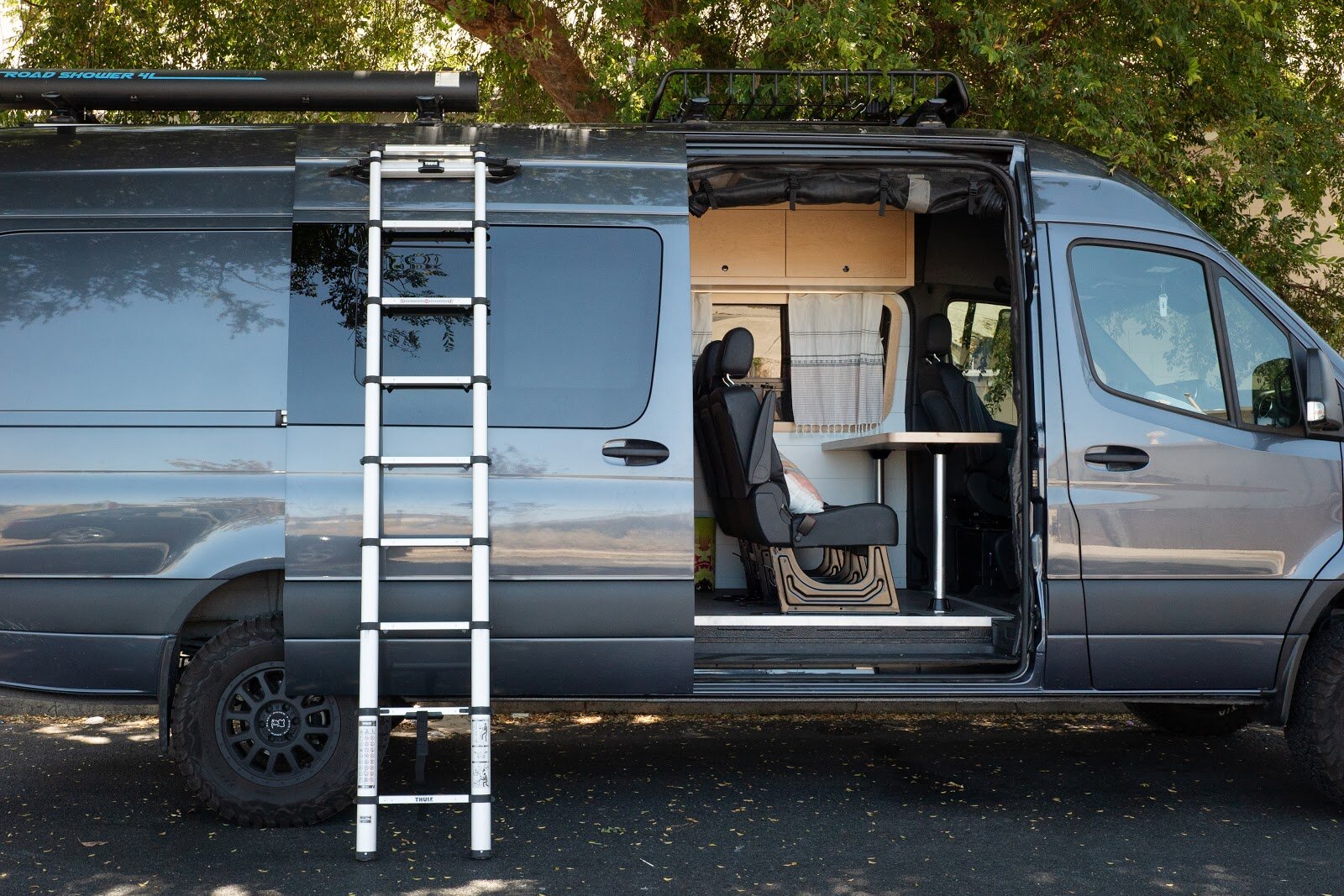
Thule Van Ladder
The Thule Van Ladder is a 9-step telescoping ladder that can be stored away when not in use. The ladder gives you access to your van’s roof, which is especially important if you have a roof rack holding gear or other items. Even without a rack, most vans can benefit from the addition of a ladder, since rooftop solar panels operate best when cleaned frequently.
A major benefit of the Thule Van Ladder is its versatility. As opposed to a fixed ladder, this telescoping ladder can be moved to access any area on your van’s roof. Magnetic pads hold the ladder securely in place against the top of your van’s siding. When you’re not using it, simply collapse the ladder and store it inside of your van.
ARB 12v Onboard Compressor
An onboard air compressor is an awesome and practical addition for many van owners. It is most useful for people that use their van for biking trips, as well as for those who find themselves in off road situations.
For bikers, the ability to quickly inflate and adjust the air pressure of tires means you can get out on rides without anything slowing you down. In offroad scenarios when lowering the air pressure of your van’s tires is beneficial, the compressor makes the deflation and reinflation process a breeze.
The ARB 12v air compressor runs off of your van’s auxiliary battery system. As long as your charging sources keep your batteries topped off, you will have access to on-demand compressed air.
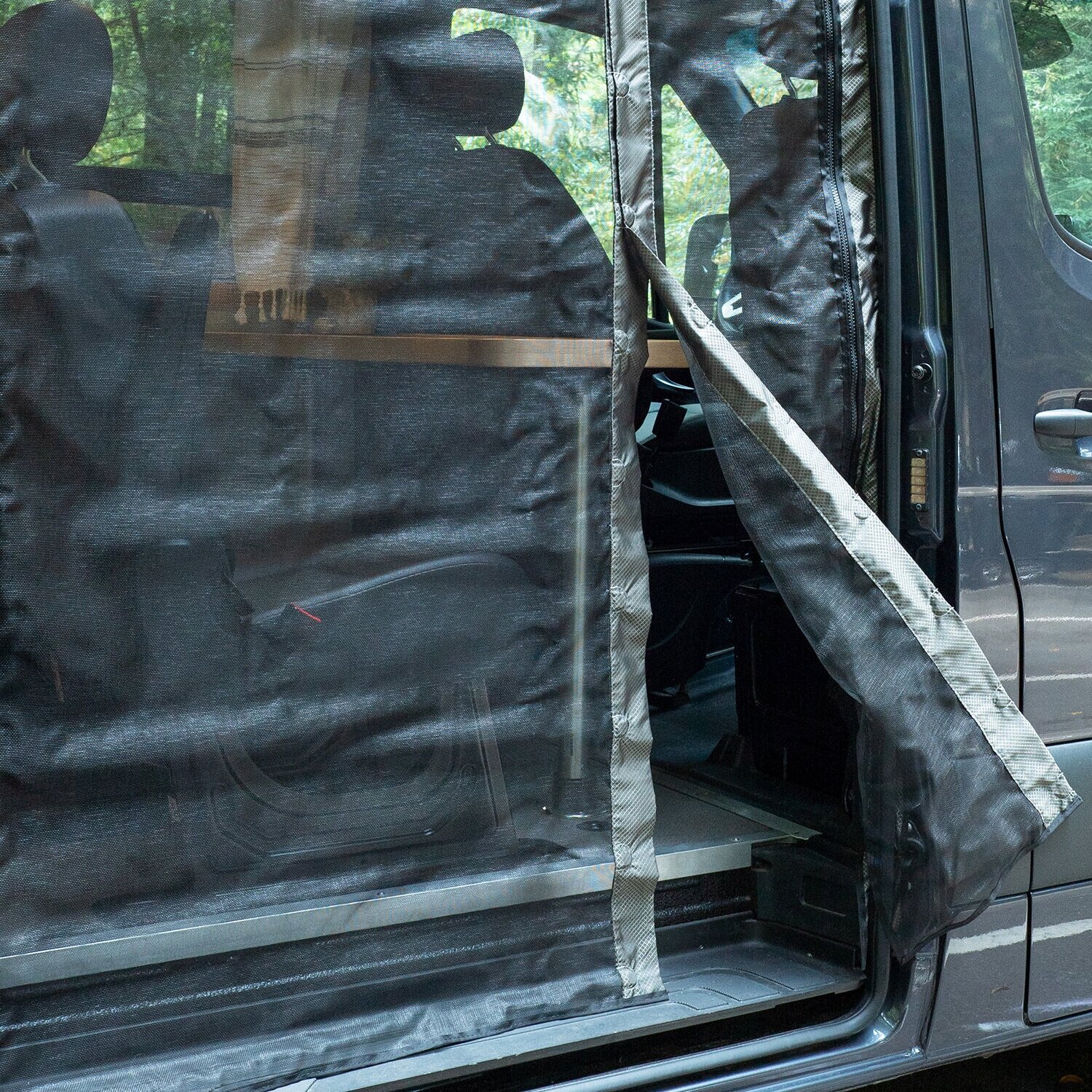
Bug Screens
Nothing beats opening your van’s sliding door to enjoy the view and fresh air on warm summer evenings. But, in many areas of the country, warm summer evenings mean swarms of mosquitoes and other insects.
Thanks to custom-made bug screens such as those manufactured by RB Components, you can still enjoy the fresh air without letting critters in. These screens are made to fit specific van models for a secure fit, and they feature a magnetic closure for easy passage in and out of your van.
Insulated Window Covers
Insulated window covers are a great item to pick up for just about any van owner. These custom-fit window coverings feature insulation, wrapped in durable blackout fabric which blocks light.
Insulation in a van is critical, both to stay warm in the winter and cool in the summer. Without insulated window coverings, the rest of your van’s insulation becomes much less effective at retaining or keeping out heat.
Another great benefit of window covers is privacy. When the lights are on in your van, anyone in the area can see clearly through the windows. Window coverings add privacy, and unlike a curtain in between the cab and rear of the van, they can be utilized even when people are sitting in the van’s front swivel chairs.
Cassette or Composting Toilet
A custom Sprinter van turns camping into GLAMping. But unlike traditional RVs, many Sprinter vans don’t come equipped with a toilet. Fortunately, there are toilet options for camper vans that are sanitary and that take up minimal space.
The two most popular options when it comes to camper van toilets are cassette and composting. Cassette toilets utilize chemicals to process waste, while composting toilets take advantage of natural processes to break down waste. Both options are popular for use in camper vans, and each is small enough to fit in a compact slide-out drawer.
5 Overlooked But Important Camper Van Features
If you’re in the market for a Sprinter van conversion, then you probably know by now that the list of features that can be added to a camper van is virtually endless. From swiveling captain’s chairs to underbed storage, custom Sprinter vans can be outfitted to accommodate just about any outdoor lifestyle.
Some features tend to get less attention than others, but that doesn’t necessarily mean they are less important. In this article, we expose some commonly overlooked camper van features, and tell you why every van needs to have these essential components.
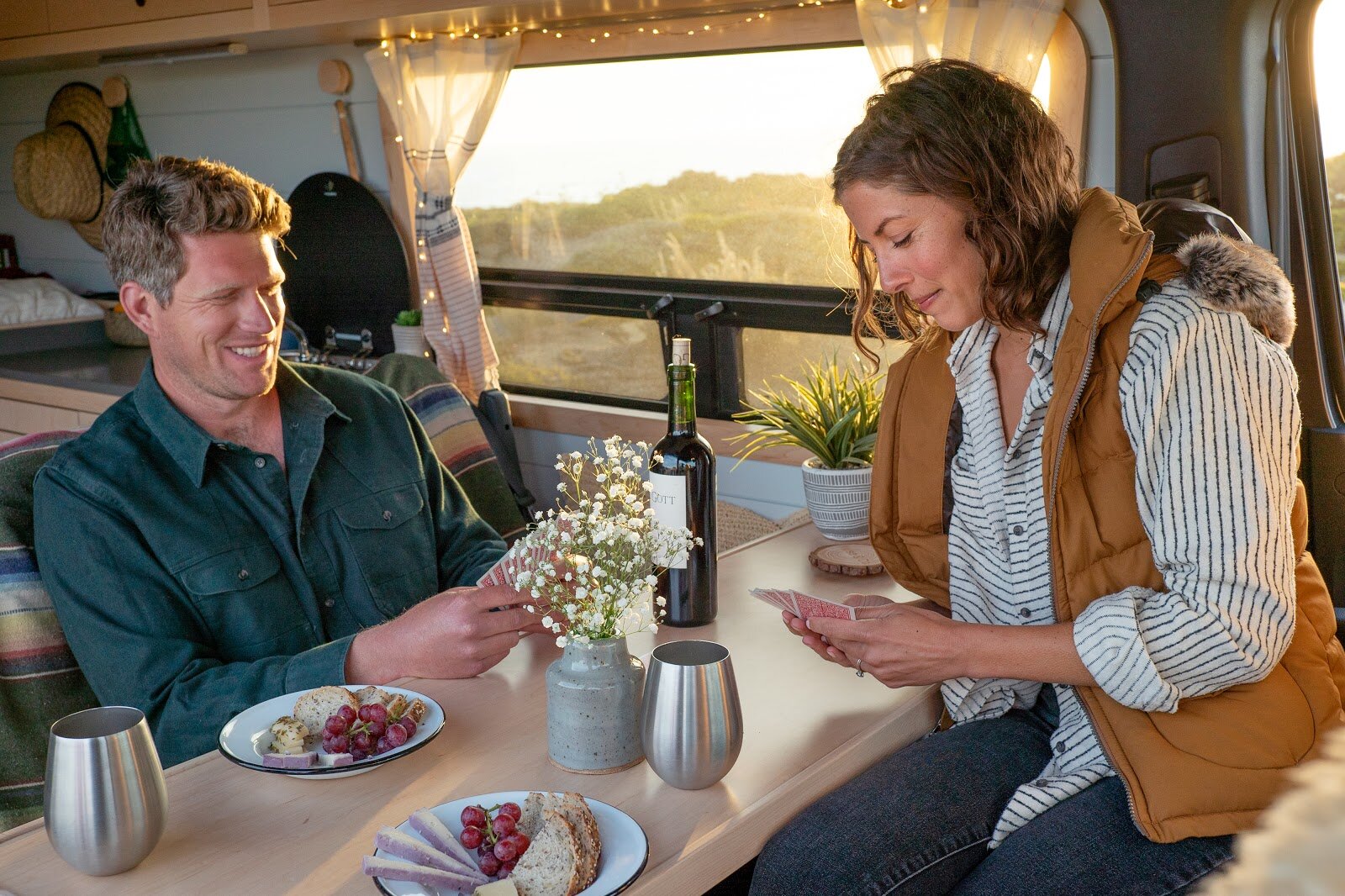
1. Effective Insulation
Keyword: effective. Nearly every professional van outfitter will add some type of insulation to the walls and ceiling of their builds, but all insulation is not created equal. Good insulation is a critical component of any quality van build. Camper van insulation should do two things effectively: regulate temperature, and regulate moisture.
In order to keep warm air in when it’s cold out, and cool air in when it’s hot out, camper van insulation should have a high R-value (a measure of an insulation’s effectiveness in regulating temperature), and should be added in every possible area of the van.
The second important job of insulation in camper vans is to prevent condensation from building up and damaging the build by creating woodrot and other issues. Havelock Wool, which is a natural sheep’s wool insulation utilized by Muse & Co. Outdoors, naturally regulates moisture by absorbing condensation when the air is saturated, and releasing it slowly into the air as it dries out. This property protects the components of your camper van build and ensures that you stay comfortable and dry in all environments.
Another bonus of Havelock Wool is that it is a completely natural and sustainable product, with zero harm to human health and minimal impact on the environment.
2. Dry Heat
One great thing that separates van life from tent camping is that you can really get out of the elements when the weather gets rough. That’s why having a heater in your van is such a great feature. Nothing beats being warm and cozy inside your little home on wheels while temperatures drop outside.
Many camper vans come with heater options, but there are some heater types that you will want to avoid. Many propane heaters are meant for use outdoors or in a ventilated environment. They not only produce deadly carbon monoxide as they are used, they also create condensation in the environments they heat. In a camper van, this spells trouble. Instead, you’ll want to go with a ventilated source of heat that is able to warm your van while venting CO and condensation to the outside.
Here at Muse & Co. Outdoors, our vans come equipped with an Espar D2 heater, which provides safe, dry, thermostat-controlled heat and taps into your Sprinter van’s diesel fuel tank to power itself! If you have a gasoline-powered van, we can install a small diesel tank to accommodate.
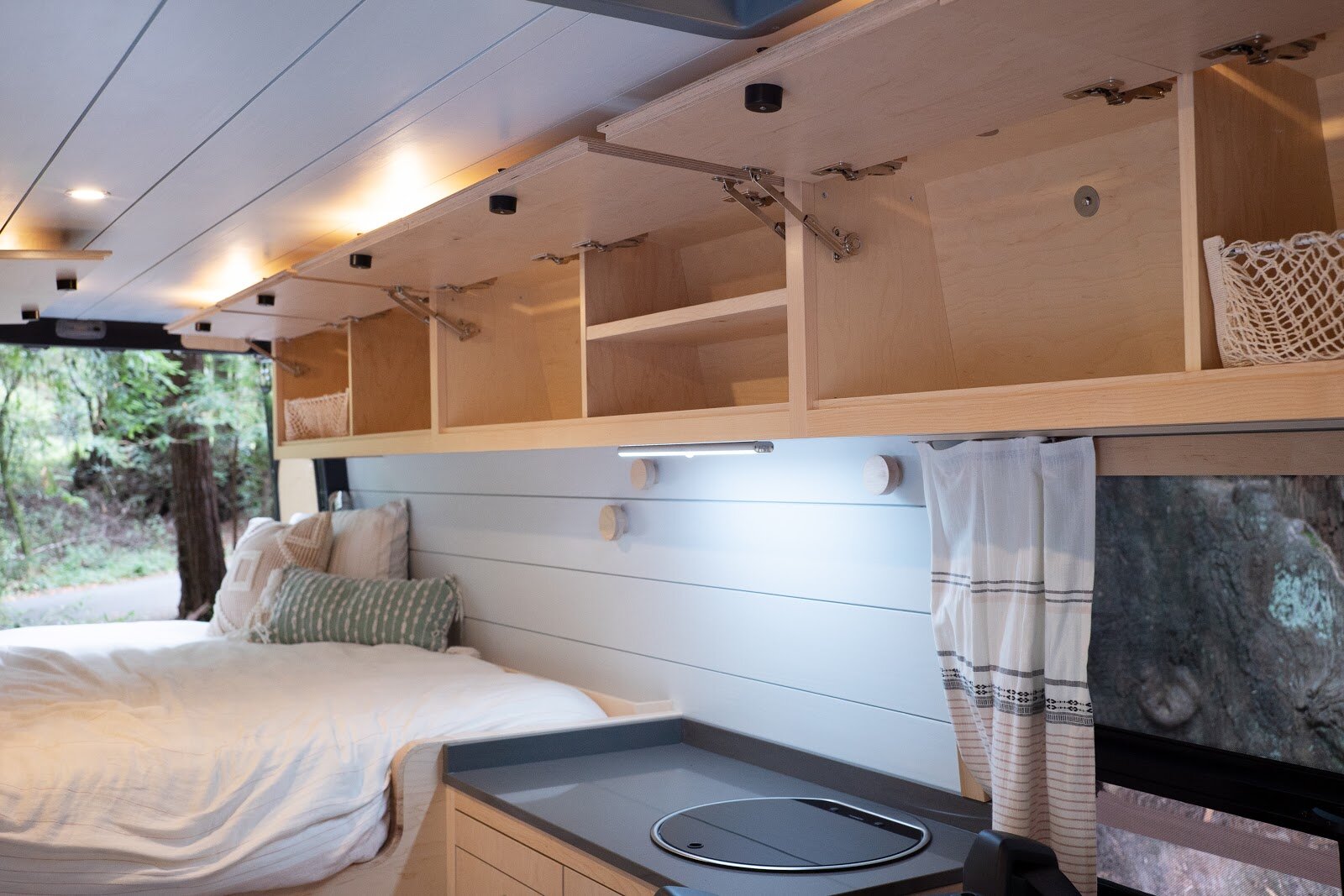
3. Quality Build Materials
When it comes to purchasing a home, some of the first things we check for are a sound foundation and the quality of the building materials and woodwork. When purchasing a converted Sprinter van, you should be paying attention to similar things.
When it comes to camper van interiors, all components of the build need to be as sturdy and secure as possible to deal with the constant bumps and movement from the road. One of the first things you should look for when purchasing a camper van is the quality of the materials used in the cabinets, walls, and other structural areas of the build.
At Muse & Co. Outdoors, we use furniture-grade wood for all of our cabinetry. Our interiors are built to withstand the bumps and twists of the road, for many years to come.
4. Ventilation
A camper van is a small and enclosed environment, and it’s essential to have airflow inside when you want it. Most vans come equipped with a ceiling vent fan that can either push air into the van, or pull it up and out.
A fan is a great way to keep things fresh inside your van. But unless you have windows that can be opened, the vent fan will be much less effective. Two great locations to place windows are near your kitchen area, and near the bed. You can then set the vent fan to pull air out through the ceiling, creating a cool breeze over your sleeping area, and pulling any cooking odors up and out of the van.
All Muse & Co. Outdoors vans come equipped with a Maxxfan Deluxe automatic ceiling fan with remote, so you don’t even have to get up out of bed to get some air flowing through your space. Plus, the Maxxfan features a rain-proof vent cover, meaning you can have the vent open and the fan on, even if it’s raining outside.
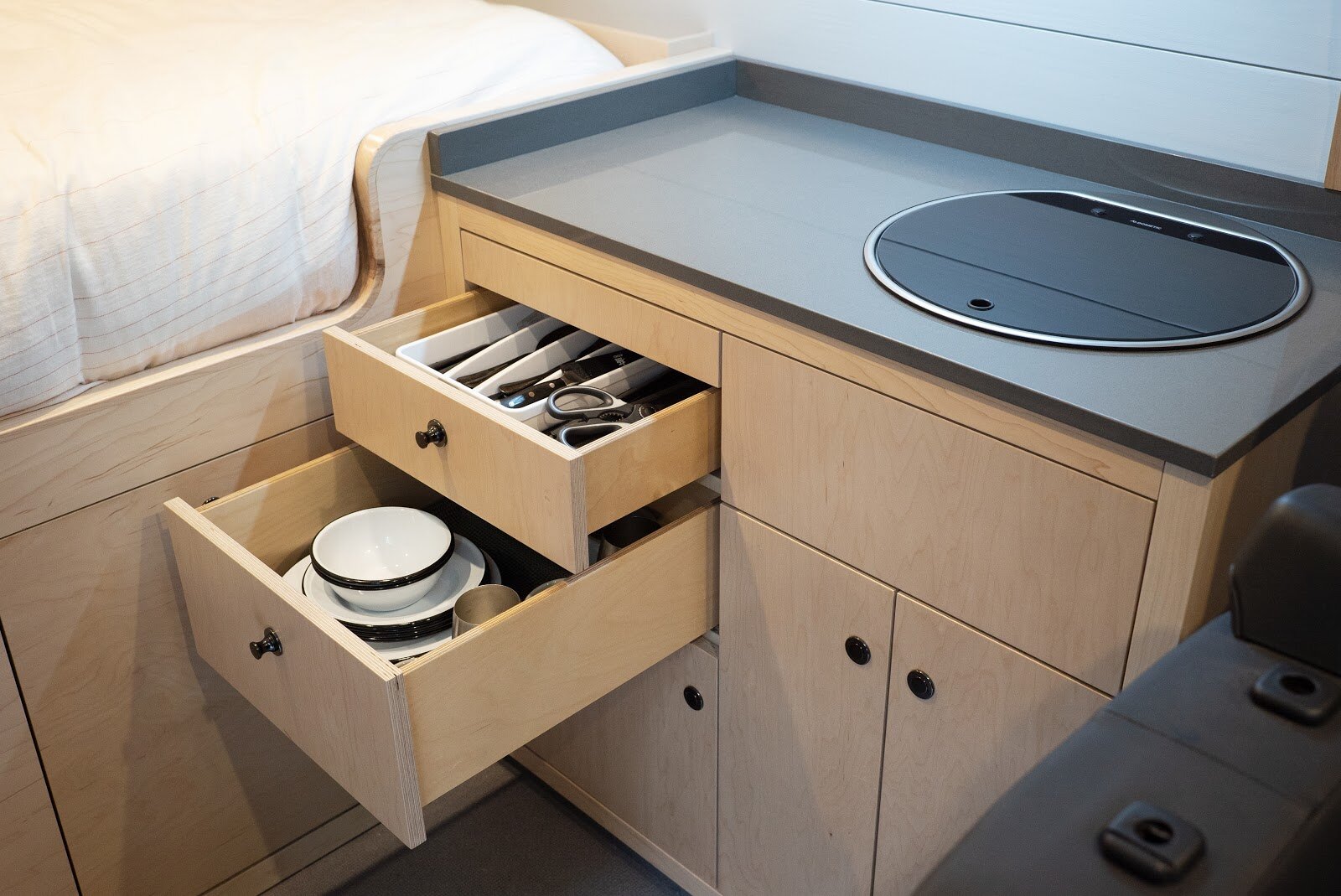
5. Storage
Storage is one of the most important features of any camper van. Cabinetry not only has a major impact on the aesthetic of your van, it is also one of the most critical functional elements. Having ample storage that looks great and works intuitively can make the difference between a good Sprinter van conversion and a great one.
In a camper van, storage is critical because it keeps things out of the way and uncluttered in your small living space. It also serves the purpose of securing loose items while you’re on the road. Your cabinets and drawers must feature mechanisms that keep them securely closed while you are in transit, without detracting from functionality and ease of use.
If you’re trying to determine the overall quality of a Sprinter conversion, a good first place to look is the cabinetry. If the van’s storage is easy to use, seamlessly designed, and thoughtfully laid out, there’s a good chance that the builder put the same attention to detail into the other areas of the camper van. Anyone can add fancy gadgets to a van conversion, but few builders have the expertise to craft storage that compromises neither on beauty, nor functionality.
The Best Western U.S. Road Trips for Your Next Camper Van Adventure
If you’ve been dreaming of #vanlife adventures, you’re not alone. There’s truly nothing better than leaving your troubles behind and hitting the open road in a custom camper van. Whether you’re new to the world of vans or a long-time road warrior, discovering new road trip ideas can be a huge source of inspiration.
We’ve created this list of the very best U.S. road trip ideas for the western U.S. to help you get out and explore the far corners of our beautiful country in your custom camper van. We have compiled road trip ideas for every season and for various timeframes. Enjoy!
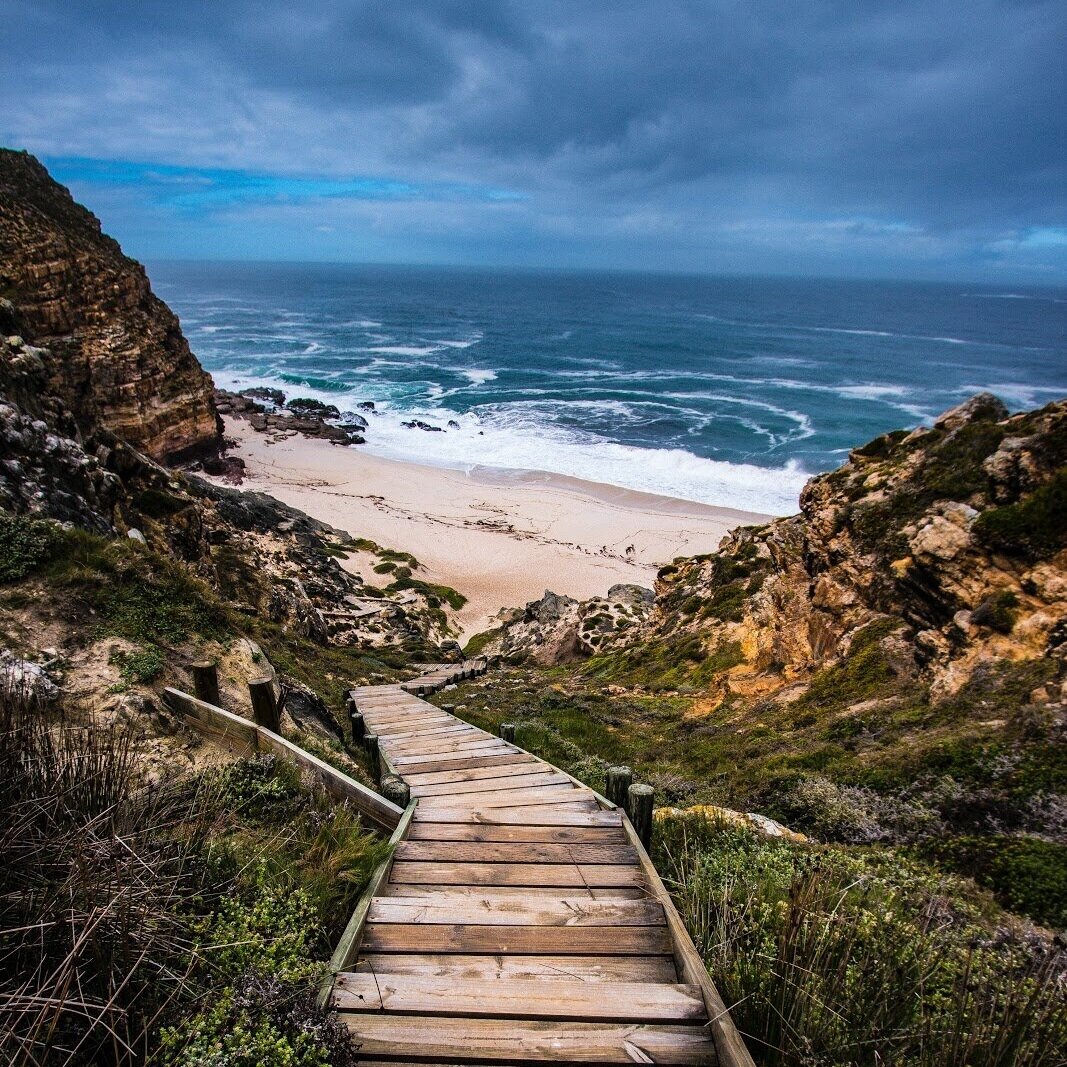
The Quintessential Pacific Coast Road Trip
We can’t make a list of U.S. road trip ideas without including a route along the beautiful Pacific Coast. Since long before the days of #vanlife, people have been taking road trips up and down the west coast of the U.S. to enjoy its breathtaking scenery and opportunities for various activities.
From the sun-soaked beaches of southern California, to the giant coastal redwoods north of San Francisco, all the way up to the temperate rainforests of western Oregon and Washington, the Pacific Coast offers a non-stop stream of natural beauty. Some favorite stops include the several van-friendly beaches along the Oregon coast, where you can take your (preferably 4×4) Sprinter van for a drive out onto the expansive sandy shores. Other must-sees include the giant redwoods of northern California, and the van life-friendly beachside community of Ventura in southern California.
Depending on how long of a trip you’re planning, you could travel just a short section of the Pacific Coast, or plan a route that includes the entire coast, from the Mexican to Canadian border. Weather and climate vary immensely depending on what section of the coast you find yourself on. Spring, Summer, and Fall can all offer great weather from border-to-border, with summer being the safest bet for sunny travel along the northern coast. If you’re traveling in winter, you’ll probably want to stay towards the southern reaches of the Pacific Coast, as these areas stay much drier and warmer during this time of the year than the rest of the route.

The Desert Getaway
If you’ve never visited the vast desert landscapes of the southwestern U.S., do yourself a favor and start that camper van up, now! From sandstone monoliths to cactus flats as far as the eye can see, the deserts of the Southwest make for a road trip you will never forget.
Few sights are as breathtaking as the massive sandstone towers and arches of southern Utah, and that’s why this area is at the very top of our must-visit locations in the Southwest. In the summer, temperatures in this area can reach well over 100 degrees. Great weather can be had in the shoulder seasons, and winter can also provide some crisp and sunny conditions. While you’re in the area, be sure to visit Arches National Park, and consider venturing out of your way for a chance to see some of the ancient rock art sites scattered around the Moab area.
Another must-visit desert locale is Red Rocks National Conservation Area outside of Las Vegas. The incredible, vibrant rock walls and canyons make for great scenery while hiking and mountain biking. Las Vegas is just minutes away, so you can even hit the strip while you’re in the area, if that’s your jam.

The Eastern Sierra Nevada Mountains
If you’re looking for a road trip idea that is off the beaten path, consider checking out California’s eastern Sierra Nevada Mountain range, accessible via U.S. Route 395. The ‘east side’, as locals call it, is home to expansive mountain views and sagebrush as far as the eye can see.
Recreation opportunities abound, with world-class hiking, climbing, fishing, and skiing all accessible from the 395 corridor. RV parks and campgrounds are scattered along Highway 395, as are opportunities for more rural camping on BLM land. While you’re in the area, be sure to check out the various wild hot springs outside of Mammoth Lakes, CA, where you can soak and enjoy wide-open views of the Sierra Nevada and White mountain ranges. You can even legally camp directly next to some of the springs!
As you journey northward along 395, make sure to stop at Mono Lake to view the other-worldly mineral deposits and spot some of the rare birds that frequent the area. If the nearby Tioga pass is open, you can easily access Yosemite National Park from this area as well. The pass is generally open from May-October.
The weather on the east side can vary wildly, but temperatures in the lower elevations usually stay fairly moderate in the spring and fall. During the winter months, nighttime temperatures consistently drop well below freezing – but fewer crowds, world-class skiing opportunities, and various hot springs make a trip to the east side during winter a possibility for many travelers. In the summer, you’ll want to stick to the higher elevations, such as the areas around Mammoth Lakes and Tuolumne Meadows. Temperatures in the lower elevations along the 395 corridor soar well above 100 degrees in the summer.
Are you looking for a Sprinter camper van to help you make these dreamy road trip ideas a reality?
Check out our models to learn more about the adventure vans we build here at Muse & Co. Outdoors!
